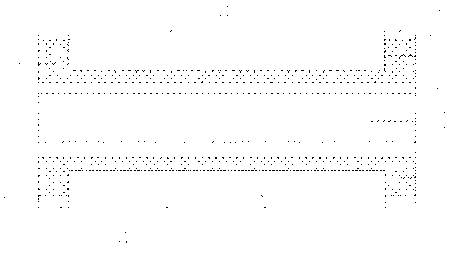Manufacturing technique of low-voltage chip and low-voltage chip thereof
A production process and chip technology, which is applied in the field of chip production and preparation, can solve problems such as large leakage, conduction, and product failure of low-voltage chips, and achieve the effects of increasing the diffusion gradient, reducing the depletion layer, and reducing the leakage value
- Summary
- Abstract
- Description
- Claims
- Application Information
AI Technical Summary
Problems solved by technology
Method used
Image
Examples
Embodiment 1
[0031] A production process for a low-voltage chip, comprising the following steps:
[0032] (1) Select P-type original silicon wafer: select P-type original silicon wafer with a resistivity of 0.002 ohm / cm and a thickness of 290 microns;
[0033] (2) Pretreatment before boron impurity diffusion: first, place the P-type raw silicon wafer selected in step (1) in a mixed acid composed of nitric acid, hydrofluoric acid and glacial acetic acid at a temperature of 1-3°C. Carry out chemical etching for 30 seconds, wherein the volume ratio of nitric acid: hydrofluoric acid: glacial acetic acid is 18:1:1; then the P-type original silicon wafer is rinsed in pure water and placed in a hydrogen peroxide, ammonia and water ratio. Heat up the prepared No. 1 solution to wash the P-type raw silicon wafer at 80°C for 10 minutes, wherein the volume ratio of hydrogen peroxide: ammonia water: water is 1:1:6; rinse with water after cleaning in No. 1 solution Clean, and then place the P-type raw ...
Embodiment 2
[0046] A production process for a low-voltage chip, comprising the following steps:
[0047] (1) Select P-type original silicon wafer: select P-type original silicon wafer with a resistivity of 0.0037 ohm / cm and a thickness of 340 microns;
[0048] (2) Pretreatment before boron impurity diffusion: first, place the P-type raw silicon wafer selected in step (1) in a mixed acid composed of nitric acid, hydrofluoric acid and glacial acetic acid at a temperature of 1-3°C. Carry out chemical etching for 30 seconds, wherein the volume ratio of nitric acid: hydrofluoric acid: glacial acetic acid is 18:1:1; then the P-type original silicon wafer is rinsed in pure water and placed in a hydrogen peroxide, ammonia and water ratio. Heating in the prepared No. 1 solution, and cleaning the P-type raw silicon wafer at 95°C for 10 minutes, wherein the volume ratio of hydrogen peroxide: ammonia water: water is 1:1:6; rinse with water after cleaning in No. 1 solution Clean, and then place the P...
Embodiment 3
[0061] A production process for a low-voltage chip, comprising the following steps:
[0062] (1) Select P-type original silicon wafer: select P-type original silicon wafer with a resistivity of 0.0035 ohm / cm and a thickness of 310 microns;
[0063] (2) Pretreatment before boron impurity diffusion: first, place the P-type raw silicon wafer selected in step (1) in a mixed acid composed of nitric acid, hydrofluoric acid and glacial acetic acid at a temperature of 1-3°C. Carry out chemical etching for 30 seconds, wherein the volume ratio of nitric acid: hydrofluoric acid: glacial acetic acid is 18:1:1; then the P-type original silicon wafer is rinsed in pure water and placed in a hydrogen peroxide, ammonia and water ratio. Heating in the prepared No. 1 liquid to heat up the P-type raw silicon wafer at 90°C for 10 minutes, wherein the volume ratio of hydrogen peroxide: ammonia water: water is 1:1:6; rinse with water after cleaning in No. 1 liquid Clean, and then place the P-type r...
PUM
 Login to View More
Login to View More Abstract
Description
Claims
Application Information
 Login to View More
Login to View More - Generate Ideas
- Intellectual Property
- Life Sciences
- Materials
- Tech Scout
- Unparalleled Data Quality
- Higher Quality Content
- 60% Fewer Hallucinations
Browse by: Latest US Patents, China's latest patents, Technical Efficacy Thesaurus, Application Domain, Technology Topic, Popular Technical Reports.
© 2025 PatSnap. All rights reserved.Legal|Privacy policy|Modern Slavery Act Transparency Statement|Sitemap|About US| Contact US: help@patsnap.com

